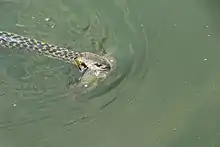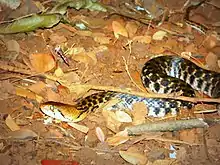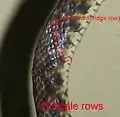Checkered keelback
The checkered keelback (Fowlea piscator), also known commonly as the Asiatic water snake, is a common speciessubfamily Natricinae of the family Colubridae. The species is endemic to Asia.
.jpg.webp)

| Checkered keelback | |
|---|---|
.JPG.webp) | |
| in Assam | |
| Scientific classification | |
| Kingdom: | Animalia |
| Phylum: | Chordata |
| Class: | Reptilia |
| Order: | Squamata |
| Suborder: | Serpentes |
| Family: | Colubridae |
| Genus: | Fowlea |
| Species: | F. piscator |
| Binomial name | |
| Fowlea piscator (Schneider, 1799) | |
| Synonyms[1] | |
Description
The eye of F. piscator is rather small and shorter than its distance from the nostril in the adult. Its rostral scale is visible from above. The internasal scales are much narrowed anteriorly and subtriangular, with the anterior angle truncated and as long as the prefrontal scales. The frontal scale is longer than its distance from the end of the snout, and as long as the parietals or a little shorter. The loreal is nearly as long as it is deep. There are one preocular and three (rarely four) post-oculars. Its temporals are 2+2 or 2+3. There are normally nine upper labials, with the fourth and fifth entering the eye; and five lower labials in contact with the anterior chin-shields, which are shorter than the posterior. The dorsal scales are arranged in 19 rows, strongly keeled, with outer rows smooth. The ventrals number 125–158, the anal is divided, and the subcaudals number 64–90. Coloration is very variable, consisting of dark spots arranged quincuncially and often separated by a whitish network, or of black longitudinal bands on a pale ground, or of dark crossbands, with or without whitish spots. Two oblique black streaks, one below and the other behind the eye, are nearly constant. The lower parts are white, with or without black margins to the shields.[2]
The checkered keelback is a medium-sized snake, but may grow to be large. Adults may attain a snout-to-vent length (SVL) of 1.75 m (5.7 ft).[3]

Defensive behavior
Most of the time this snake tries to raise its head as much as possible and expand its neck skin mimicking a cobra hood and intimidate the threat.Though it is non-veomus for human.
F. piscator may lose its tail as an escape mechanism. A rare case of such autotomy is reported from Vietnam.[4]
Habitat
The preferred habitat of F. piscator is in or near freshwater lakes or rivers.
Diet
F. piscator feeds mainly on small fish and water frogs.
Reproduction
F. piscator is oviparous. Clutch size is usually 30-70 eggs, but may be as few as 4 or as many as 100. Egg size is also variable. Each egg may be 1.5–4.0 cm (0.59–1.57 in) long. The female guards the eggs until they hatch. Each hatchling is about 11 cm (4.3 in) long.[3]
Geographic range.
F. piscator is found in Afghanistan, Bangladesh, Pakistan, Sri Lanka, India, Myanmar, Nepal, Thailand, Laos, Cambodia, Vietnam, West Malaysia, China (Zhejiang, Jiangxi, Fujian, Guangdong, Hainan, Guangxi, Yunnan), Taiwan, and Indonesia (Sumatra, Java, Borneo, Celebes = Sulawesi)
type locality: "East Indies".
Subspecies
- F. p. melanzostus (Gravenhorst, 1807) – Indonesia (Borneo [?], Java, Sulawesi [?]; Sumatra), India (Andaman and Nicobar Islands)
- F. p. piscator (Schneider, 1799) – Bangladesh, Bhutan, India, Myanmar, Pakistan, People's Republic of China (including Hainan), Sri Lanka, Taiwan, and Thailand
Nota bene: A trinomial authority in parentheses indicates that the subspecies was originally described in a genus other than Fowlea.
Taxonomy
The subspecies F. p. melanzostus was raised to species status, as Fowlea melanzostus, by Indraneil Das in 1996.
Local names
- Mizo – tui rul
- Assamese – ঢোঁৰা সাপ
- Bengali – জল ডোরা সাপ/ধোরা সাপ
- Odia – ଧଣ୍ଡ ସାପ
- Gujarati – dendu saap
- Hindi – dendu saap
- Indonesia – bandotan tutul
- Kannada – ನೀರು ಹಾವು
- Marathi – दिवड
- Malayalam – നീർക്കോലി,പുളവൻ
- Tamil – கண்டங்கண்டை நீர்க்கோலி (kandangkandai neerkoli)
- Telugu – నీరు కట్టే (neeru katte)
- Bihari – dhoriya saap
- Nepali – dhode/dhoriya saap
- Chinese (Traditional Chinese) – "漁游蛇"
- Chinese (Simplified Chinese) – "渔游蛇"
- Sinhalese - "දිය බරියා"
Gallery for identification characteristics
 Chart 1 - Nostrils directed slightly upwards
Chart 1 - Nostrils directed slightly upwards Chart 2 - Frontal constricted in the middle, twice as long as broad
Chart 2 - Frontal constricted in the middle, twice as long as broad Chart 3 - Internasals much narrowed anteriorly, nearly as long as the prefrontals
Chart 3 - Internasals much narrowed anteriorly, nearly as long as the prefrontals Chart 4 - One preocular scale only
Chart 4 - One preocular scale only Chart 5 - Temporals are 2+2 or 2+3
Chart 5 - Temporals are 2+2 or 2+3 Chart 6 - 9 supralabials, 4th and 5th touching the eye, the 6th excluded by the lowest postocular
Chart 6 - 9 supralabials, 4th and 5th touching the eye, the 6th excluded by the lowest postocular Chart 7 - Body rather stout
Chart 7 - Body rather stout Chart 8 - Small tail
Chart 8 - Small tail Chart 9 - Scales in 19 distinct rows
Chart 9 - Scales in 19 distinct rows Body of checkered keelback
Body of checkered keelback
 Checkered keelback basking
Checkered keelback basking Scale pattern
Scale pattern
References
- Species Xenochrophis piscator at The Reptile Database . www.reptile-database.org.
- Boulenger GA (1890). The Fauna of British India, Including Ceylon and Burma. Reptilia and Batrachia. London: Secretary of State for India in Council. (Taylor and Francis, printers). xviii + 541 pp. (Tropidonotus piscator, pp. 349-350).
- Das I (2002). A Photographic Guide to Snakes and other Reptiles of India. Sanibel Island, Florida: Ralph Curtis Books. 144 pp. ISBN 0-88359-056-5. (Xenochrophis piscator, p. 48).
- Ananjeva NB, Orlov NL (1994). "Caudal Autotomy in Colubrid Snake Xenochrophis piscator From Vietnam" Russian Journal of Herpetology 1 (2): 169-171.
Further reading
- Boulenger GA (1893). Catalogue of the Snakes in the .Volume I., Containing the Families ... Colubridæ Aglyphæ, part. London: Trustees of the British Museum (Natural History). (Taylor and Francis, printers). xiii + 448 pp. + Plates I-XXVIII. (Tropidonotus piscator, pp. 230-232).
- Dutt, Kalma (1970). "Chromosome Variation in Two Populations of Xenochrophis piscator Schn. from North and South India (Serpentes, Colubridae)". Cytologia 35: 455–464.
- Schneider JG (1799). Historiae Amphibiorum naturalis et literariae. Fasciculus Primus, continens Ranas, Calamitas, Bufones, Salamandras et Hydros. Jena: F. Frommann. xiii + 264 pp. + corrigenda + Plate I. (Hydrus piscator, new species, pp. 247-248). (in Latin).
- Smith MA (1943). The Fauna of British India, Ceylon and Burma, Including the Whole of the Indo-Chinese Sub-region. Amphibia and Reptilia. Vol. III.—Serpentes. London: Secretary of State for India. (Taylor and Francis, printers). xii + 583 pp. (Tropidonotus piscator, pp. 293-296, Figures 95-96).
External links
| Wikimedia Commons has media related to Xenochrophis piscator. |